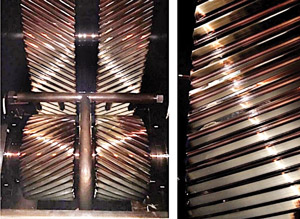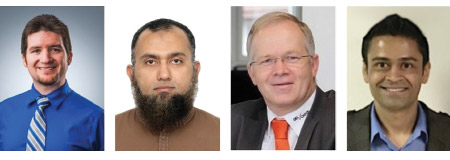

Even one of the world’s most modern
and efficient gas turbines,
a Siemens SGT 800, experiences varnish,
despite having separate lube and
hydraulic oil reservoirs.
Photo courtesy of Muhammad Uddin.
Since 2001, the International Council for Machinery Lubrication (ICML) has served as the authoritative certification body for front-line lubrication and oil analysis practitioners. Its exams are derived from bodies of knowledge curated and vetted by teams of volunteer subject-matter experts all over the world.
While ICML’s current certifications cover the fields of oil analysis and lubrication technology, the organization will soon offer specialty certifications within these broad fields as part of the new Lubrication Education Badge Program (LEBP).
Why a Badge Program?
ICML’s experience has shown that personnel who have earned Machine Lubricant Analyst (MLA) and Machine Lubrication Technician (MLT) certifications can save time and money through implementation of best practices.
Such newfound efficiency opens opportunities for these practitioners to dedicate their attention toward specific problem areas, thus increasing their value to employers and clients. The ICML board of directors surmised that specialized certification badges could help practitioners address such problem areas effectively.
“The program is founded on a series of short-duration training sessions that provide focused learning on fewer topics than our larger certification programs,” explains Alec Meinke, who serves on ICML’s board of directors and coordinates the badge program.
“Not only will the badge program improve machinery reliability and life-cycle costs through the collaborative application of best practices, but we will also incorporate benefits-awareness training for industrial stakeholders and financial decision-makers.”
Some plants may find it practical to hire or engage badge specialists rather than lubrication generalists. Instead of focusing on hierarchical certification levels, the LEBP can provide end users with flexibility to match training and certification to their plant’s specific needs.
A badge will function like a traditional certification. It will involve similar requirements, utilize its own body of knowledge for training purposes and feature a three-year lifespan, although the badge exam likely will be shorter than a standard exam.
Badges will be offered as standalone certifications rather than supplements, regardless of whether a candidate has previously earned any other ICML certifications.
Why Varnish?
Due for rollout in late 2019, the badge program’s initial offering will be the Varnish and Deposit Prevention and Removal (VDPR) certification badge.
With this badge, practitioners can validate their qualifications to perform tasks related to lubricant degradation, lube-derived deposits, contaminant interactions, proactive mitigation technologies and more.
The ICML board selected varnish as the initial LEBP topic because its prevalence in the field merits a standalone training curriculum and because varnish challenges are on the rise.
“Deposits and varnish comprise one of the major problems we face, and there has been a huge increase in recent years due to more powerful equipment, modern lubricant chemistry and more demanding working conditions,” observes Rüdiger Krethe, managing director at OilDoc. “They are responsible for a serious number of component failures and unscheduled downtime in many applications. A standalone certificate gives proper attention to this matter and what is needed to overcome it.”
Krethe was one of several volunteer subject-matter experts invited by the ICML board to form a committee to develop the new varnish badge. Other committee members include Muhammad Naseer Uddin of Petroleum Development Oman, Jatin Mehta of Fluitec International and Matt Hobbs of EPT.
“Varnish is currently a significant problem in many industries since it impacts a wide range of critical industrial equipment like turbines, compressors and hydraulic control systems,” says Hobbs. “In our daily work, we all see end users frustrated by varnish problems. While we would always recommend as much training as possible with general certifications like MLA or MLT so that end users can become well-rounded lubrication professionals, the standalone nature of the VDPR badge may be useful for those with specific concerns relating to varnish.”
Mehta suggests that ongoing education actually accelerates the need for varnish and deposit specialization.
“As more people become aware of proactive maintenance practices, there is a desire to learn more about the difficulties faced due to oil degradation,” he says. “There is a need to understand the formation and mitigation of varnish and its costly impact on machine reliability, uptime and profitability.”
The basics of varnish are well-documented. Machinery Lubrication readers certainly are aware that, even under normal operating conditions, lubricating oil breaks down from extended thermal and mechanical stress, resulting in oxidation that can lead to varnish formation.
Varnish is a highly viscous mixture of degradation byproducts - solids, liquids and gases. It generally accretes in machinery by combining readily with any variety of routine contaminants such as carbon-based dirt, metallic particles, water droplets, etc.
If varnish were found only in cases of abuse or neglect, the corrective maintenance solutions would be obvious and ICML likely would not have considered a certification badge for it.
However, varnish is produced naturally even through normal operations, which is why it is a continuous challenge for all maintenance personnel - whether they know it or not - even in the most well-maintained machines.
One of the first high-profile papers on the growing challenges of varnish in machinery lubrication was written in 1999 by ICML board member and Noria CEO Jim Fitch. Over the years, Fluitec’s Greg Livingstone has published multiple papers on oil degradation and varnish mitigation.
Livingstone was also instrumental in developing a method for measuring varnish potential, which is now an ASTM test method. Even with such ongoing research and attention, technology’s pace makes varnish a moving target in actual practice.
Echoing Krethe’s comments, Mehta believes that “ever-evolving base-stock technology, additives and advances in equipment design bring in more unique challenges to the understanding of modes of degradation, prevention and removal.”
“Many end users still do not fully understand what varnish is, how it forms and what solution will be best for their needs,” notes Hobbs.
“There is a desperate need to raise the level of awareness with industrial professionals who are responsible to keep machines running for uninterrupted production,” adds Uddin. “Developing the VDPR badge is the right step for ICML to take to raise the level of awareness among professionals for improved business performance globally.”

ICML invited volunteer experts to develop the Varnish and Deposit Prevention and Removal certification badge. The team includes (from left to right) EPT's Matt Hobbs, Petroleum Development Oman's Muhammad Naseer Uddin, OilDoc's Rüdiger Krethe and Fluitec International's Jatin Mehta.
The Volunteer Expert Team
Putting the right team together is always key to the success of these types of projects. Hobbs, Krethe, Uddin and Mehta all jumped at the opportunity to develop ICML’s inaugural badge. Krethe was first invited by ICML to turn his attention to varnish matters in 2016. He was joined by Hobbs and Uddin in 2017.
However, the nature of long-distance communication proved challenging at the outset. Krethe is based in Germany, while Hobbs is in Canada and Uddin in Oman. When the three men finally met face to face at the 2018 Reliable Plant Conference & Exhibition in Indianapolis, that’s when things really started to click.
“From that time forward, our meetings were very productive,” Hobbs says. “We were joined by Jatin Mehta (in New Jersey) shortly thereafter.”
“Our working team comprises various areas of expertise in the field of lubricant varnish,” explains Uddin. “Me, from the lubricant end-user’s perspective, to oil analysis expertise labs and oil treatment and varnish-removal professionals.”
The foursome collaborated quickly to develop a body of knowledge (BoK) library which they believed would best provide VDPR candidates with the knowledge required to effectively solve their varnish problems.
“We had lots of healthy debate and discussion about which topics to include in the BoK,” recalls Mehta. “We tried to include all the real-world scenarios of oil breakdown, maintenance challenges, mechanical issues, mitigation and condition monitoring which directly affect the bottom line of a plant.”
Impact of the Badge Program
The VDPR team sees a bright future not just for the varnish badge but also for the overall LEBP initiative.
“It is our hope that the VDPR badge will give end users the tools they need to effectively solve their varnish problems,” Hobbs says. “A wide variety of varnish solutions are currently available on the market, but we want end users to have the knowledge that they require to make choices that will be effective in their specific circumstances.”
So far, the enthusiasm among the varnish team’s members bodes well for the development of more ICML badges under the LEBP umbrella.
“We are all eager to forge ahead with the badge creation to provide end users with the tools they require to ensure the performance and reliability of their critical assets,” Hobbs adds.
Of course, the value of earning a VDPR badge and other certifications could be described as incalculable.
“I hope that the knowledge gained from this badge would readily be implemented by the professionals at their workplaces to improve businesses and save millions of dollars for their companies,” Uddin notes.
The VDPR committee continues to write and vet exam questions. ICML expects to make the new badge available in late 2019, with others to follow. Subject-matter experts interested in learning more about volunteer opportunities to develop future education badges or to participate in other industry-wide ICML activities may send inquiries to Paul Hiller at paulh@lubecouncil.org.


.jpeg)

